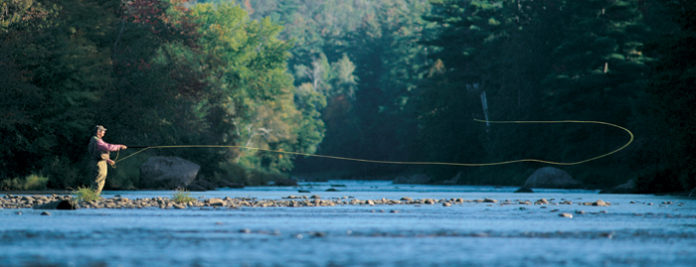Written by: Bill Cairns
Bill Cairns was a pioneer in fly-fishing instruction and a Master Caster.
[Editor’s note: Reader Jeffrey Harris sent in the text below, along with this note: “Bill Cairns’s thoughts on stream etiquette bear repeating from time to time. Here’s my retyped version from my tattered copy he gave me 20 years ago. I hope you’ll share it with your readers and Orvis customers.” We wrote about Bill when he passed away in 2013. Thanks to Mr. Harris for this great reminder of Bill’s legacy. This is still good advice.]
It used to be that most new fishermen were gradually introduced to the sport of fly fishing by a family member or friend who had a fishing background, and various rules of behavior would be acquired over time and adhered to as a matter of course. Nowadays, we welcome many adult newcomers to the sport with no tradition to rely on for guidance so streamside misunderstanding can easily arise.
The rules of streamside behavior are few and easily observed. Mostly they revolve around common sense, courtesy, and consideration of others sharing the stream.
- A section of water belongs to the first fisherman fishing it. It is inconsiderate to crowd him and just how close an approach is permissible is an obvious variable.
- A slow-moving or stationary fisherman has every right to remain just where he is. If you are moving, leave the water and walk around him, being certain not to disturb his fishing or the water he might be working. In a similar vein, a fisherman may be resting a pool or planning his next move. It is still his water, and you should not jump in without his permission.
- A fisherman working in an upstream direction has the right of way over someone coming downstream. Wading upstream against the current forces you to move slowly, cover less water, and you are approaching the fish from behind. The fisherman working in a downstream direction covers more water, more quickly, and has the potential to disturb more water. For instance, careless wading could send silt or debris washing downstream to alarm fish that someone else is working over.
- Many streams flow through private property. Recognize that access is a privilege, not a right. Respect private property. If unsure about access, ask the landowner politely. On farm properties: don’t trample crops, disturb livestock, or leave gates open.
- Leave no litter at streamside. In fact, get in the habit of picking up discarded monofilament, cans and other trash, carrying them out to be discarded properly.
- Recognize that skilled anglers and/or heavy fishing pressure with excessively liberal limits can greatly reduce the available fish populations in any stream section unless voluntary restraint is practiced. A legal limit is not a quota. Let your fishing motto be: “Limit your kill; don’t kill your limit.” Orvis encourages the catch-and-release philosophy of angling, allowing fish to mature, reproduce, and live to challenge other anglers in the future.
- Multiple recreational use of streams is common. We may share the resource with tubes and canoes. It is the responsibility of the canoer to recognize that the angler has established a position before the canoe floated into view. The canoer should try to pass behind the angler. If space doesn’t permit this, the canoer should float by quietly and with minimum disturbance.
In summary, behave on stream towards other anglers as you would like them to behave towards you. . .and welcome to the world of fly fishing.
Bill Cairns is a legend in fly fishing. He was a fly fishing teacher, ambassador, historian, rod builder, fly tier, and one of the best casters ever. He founded the first fly fishing school in 1966 at the Orvis Company. The fly fishing world lost a true gentleman in 2013 when Bill was 81 years old.
Credit: Source link































